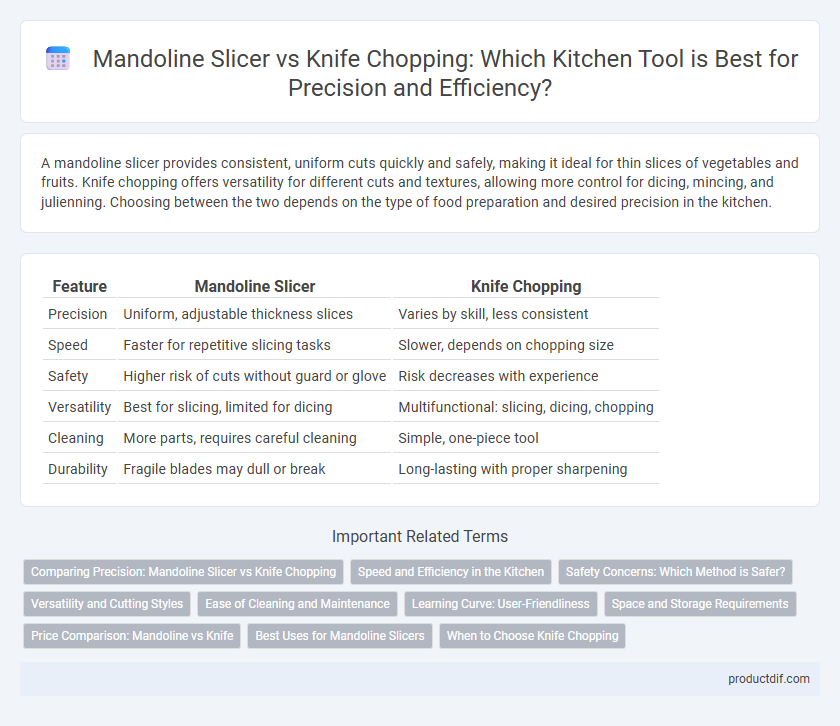A mandoline slicer provides consistent, uniform cuts quickly and safely, making it ideal for thin slices of vegetables and fruits. Knife chopping offers versatility for different cuts and textures, allowing more control for dicing, mincing, and julienning. Choosing between the two depends on the type of food preparation and desired precision in the kitchen.
Table of Comparison
| Feature | Mandoline Slicer | Knife Chopping |
|---|---|---|
| Precision | Uniform, adjustable thickness slices | Varies by skill, less consistent |
| Speed | Faster for repetitive slicing tasks | Slower, depends on chopping size |
| Safety | Higher risk of cuts without guard or glove | Risk decreases with experience |
| Versatility | Best for slicing, limited for dicing | Multifunctional: slicing, dicing, chopping |
| Cleaning | More parts, requires careful cleaning | Simple, one-piece tool |
| Durability | Fragile blades may dull or break | Long-lasting with proper sharpening |
Comparing Precision: Mandoline Slicer vs Knife Chopping
Mandoline slicers provide unmatched precision with uniform slices, typically adjustable to millimeter increments for consistent thickness. Knife chopping relies heavily on the user's skill, leading to variations in slice size and shape, which can affect cooking times and presentation. Professional chefs often favor mandolines for repetitive fine slicing, while knives remain versatile for irregular cuts and dicing.
Speed and Efficiency in the Kitchen
A mandoline slicer significantly speeds up food preparation by offering uniform, precise slices in seconds, outperforming knife chopping in efficiency. Unlike knives, which require skill and time to achieve consistent cuts, mandoline slicers reduce prep time and minimize effort for slicing vegetables and fruits. This tool enhances productivity in busy kitchens, making it ideal for tasks needing rapid, uniform cuts.
Safety Concerns: Which Method is Safer?
Mandoline slicers offer precise, uniform cuts but pose higher risks of serious lacerations without proper hand guards and cautious use. Knife chopping requires skill to maintain control and prevent slips, with safety greatly improved by using a sharp blade and effective cutting techniques. When comparing safety, knife chopping generally presents fewer injury risks for most home cooks compared to the sharp, exposed blades of mandoline slicers.
Versatility and Cutting Styles
Mandoline slicers offer precise, uniform cuts and adjustable thickness settings ideal for slicing, julienning, and crinkle cuts, enhancing versatility in food preparation. Knife chopping provides greater adaptability for a wide range of cuts including dicing, mincing, and fine chopping, accommodating more complex culinary techniques. Both tools complement each other, with mandolines excelling in speed and consistency while knives deliver nuanced control for diverse cutting styles.
Ease of Cleaning and Maintenance
Mandoline slicers often feature removable blades and non-stick surfaces, making them easier to clean compared to traditional knives that require thorough hand washing to remove food residue. Dishwasher-safe parts on many mandolines reduce maintenance time, while knives demand regular sharpening and careful drying to prevent rusting. Proper care extends the lifespan of both tools, but mandolines generally offer more convenience for cleaning and upkeep.
Learning Curve: User-Friendliness
Mandoline slicers offer consistent, precise cuts with minimal effort, making them user-friendly for those seeking uniform slices quickly. Knife chopping requires more skill and practice to achieve similar precision, with a steeper learning curve for safe and efficient handling. Users new to kitchen tools often find mandolines easier to master, while knife proficiency improves with experience over time.
Space and Storage Requirements
Mandoline slicers offer compact design that fits easily into kitchen drawers or small cabinets, making them ideal for limited space environments. Unlike bulky knives and cutting boards, mandolines require minimal storage area and reduce countertop clutter. Efficient storage solutions optimize kitchen organization without sacrificing functionality during food preparation.
Price Comparison: Mandoline vs Knife
Mandoline slicers typically range from $20 to $100 depending on brand and features, while quality kitchen knives vary from $30 for basic models to over $200 for premium options. Mandolines offer efficient slicing at a lower entry cost but may require replacement parts. Knives provide versatile chopping functions and, with proper care, can last a lifetime, which may justify their higher initial investment.
Best Uses for Mandoline Slicers
Mandoline slicers excel in producing uniform, thin slices quickly, making them ideal for vegetables like cucumbers, potatoes, and carrots in salads or chips. Their precision ensures consistent cooking times and presentation, unmatched by knife chopping's variability. Best suited for repetitive slicing tasks, mandolines save time and enhance efficiency in both home and professional kitchens.
When to Choose Knife Chopping
Knife chopping is ideal for precision cutting and handling delicate ingredients like herbs or garlic, providing greater control over size and texture. It offers versatility for complex cuts such as dicing, mincing, and julienning, which a mandoline slicer cannot achieve efficiently. For recipes requiring varied shapes or when working with irregularly shaped produce, knife chopping ensures optimal results and safety.
Mandoline Slicer vs Knife Chopping Infographic

 productdif.com
productdif.com